The Mundelein College Skyscraper
Mundelein Center for Fine and Performing Arts
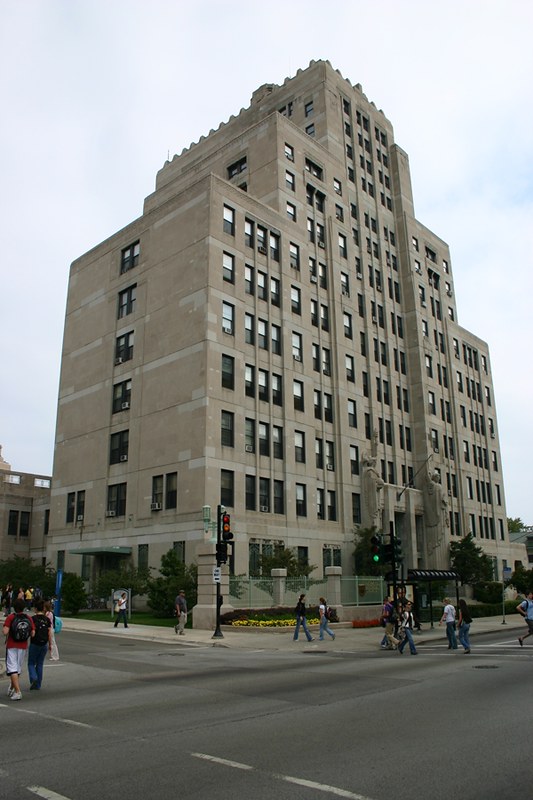
History
In 1930, the Sisters of Charity of the Blessed Virgin Mary (BVM) opened the ornate metalwork doors of the Mundelein College Skyscraper building to students for the first time. In 1980, the steel and concrete building was listed on the National Register of Historic Places because of its Art Deco design and its unique place in history as the only self-contained modern skyscraper constructed for the express purpose of educating women. For sixty-one years, the building hosted Mundelein College, and in 1991, when Mundelein affiliated with Loyola, it became a vital part of Loyola University Chicago’s Lake Shore Campus. In 2008, the building was restored and is now home to Loyola’s Mundelein Center for Fine and Performing Arts.
Download the Skyscraper Building Fact Sheet!
.jpg)
Projected blueprint for the Skyscraper conceived of in the colonial style.
Women and Leadership Archives Image 2959
From its inception, Mundelein co-founders, Mother Isabella Kane, BVM and Sister Justitia Coffey, BVM had a clear idea of the kind of building they hoped for. Historian Prudence Moylan asserts that both women were “attuned to the tempo of their times.” The building they envisioned needed to be a skyscraper for practical reasons because land was not cheap in the city. In addition, the space they hoped for would be set in a modern building built in a twentieth-century style because Mundelein would be a school for women who would function in the commercial city of Chicago. Mother Isabella and Sister Justitia preferred the clean lines of more modern architecture and were determined to carry out their plan despite a difference of opinion with Cardinal George William Mundelein, their superior. The Cardinal appointed the first architect of the building, Joseph McCarthy, who aimed to give the building a colonial appearance reflected in the blueprint above. Mother Isabella responded by hiring a younger architect, Nairne Fisher to conceive of a skyscraper in the Art Deco style which had been popularized in the 1925 Paris World’s Fair. The form symbolized both the beauty and efficiency of the modern world.
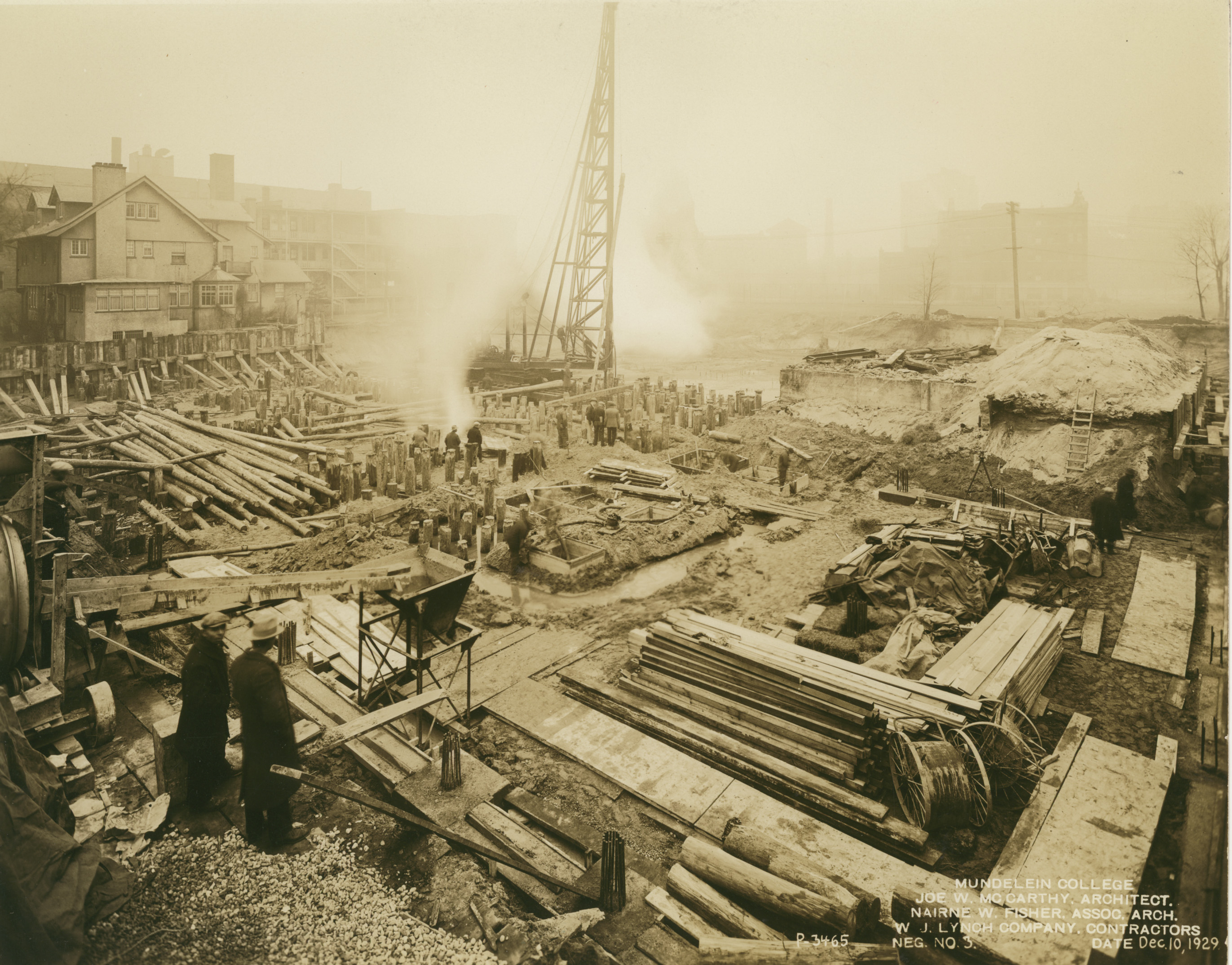
1930: building: Skyscraper Construction
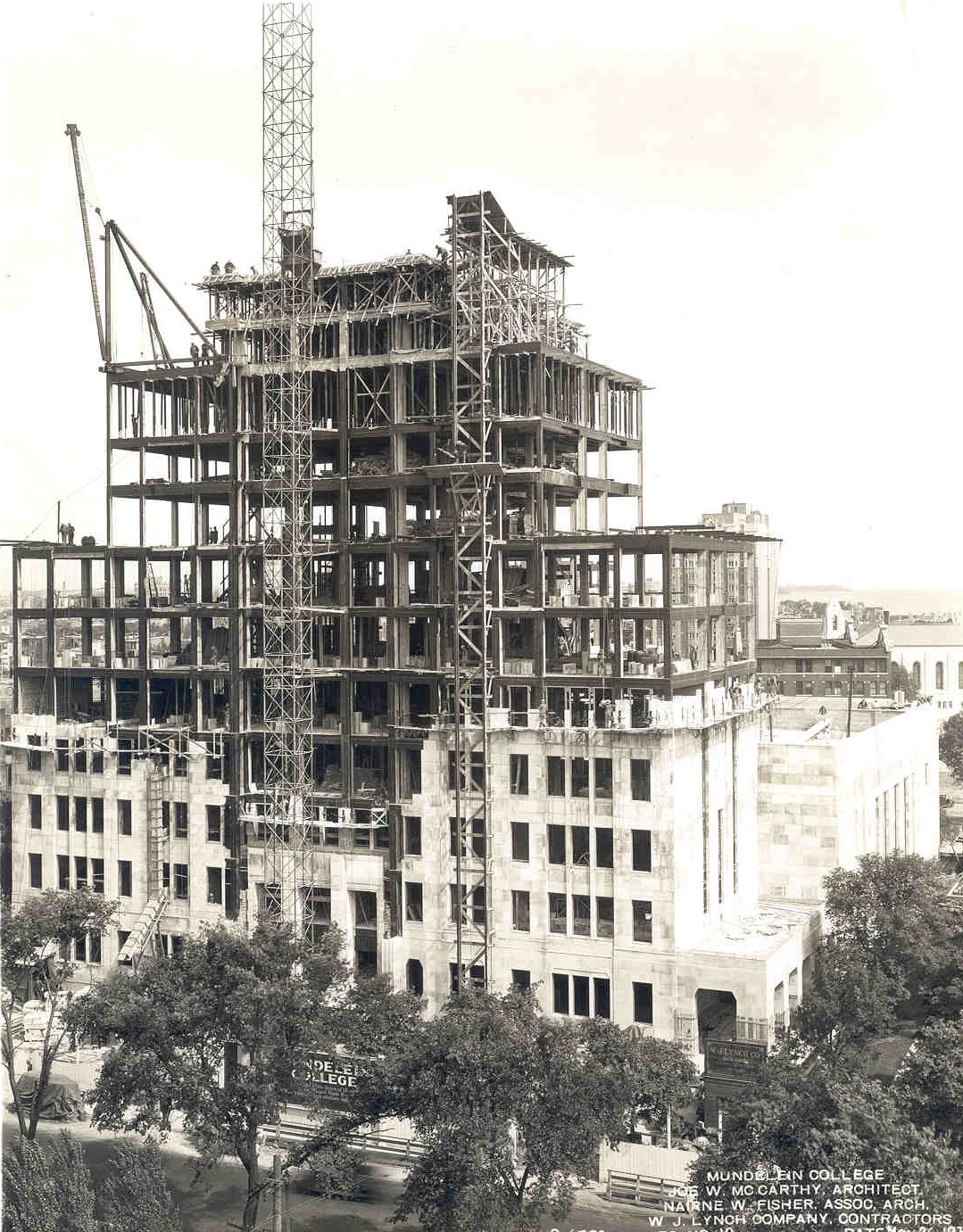
1930: Building: Skyscraper Construction
Sister Justitia closely supervised the building’s construction. She started each day with a brisk walk down Rosemont and Kenmore Avenues towards the rising building on Sheridan Road accompanied by a young novitiate (a woman religious in training) and a tricolor collie named Prince. While they strolled on the site, Sister Justitia discussed workflow with the construction manager, William Lynch, and the many builders whom she knew by name. During construction, she also kept close tabs on permits with officials in downtown Chicago and assured a steady stream of incoming supplies with merchants so that the school could open its doors to students the following fall.
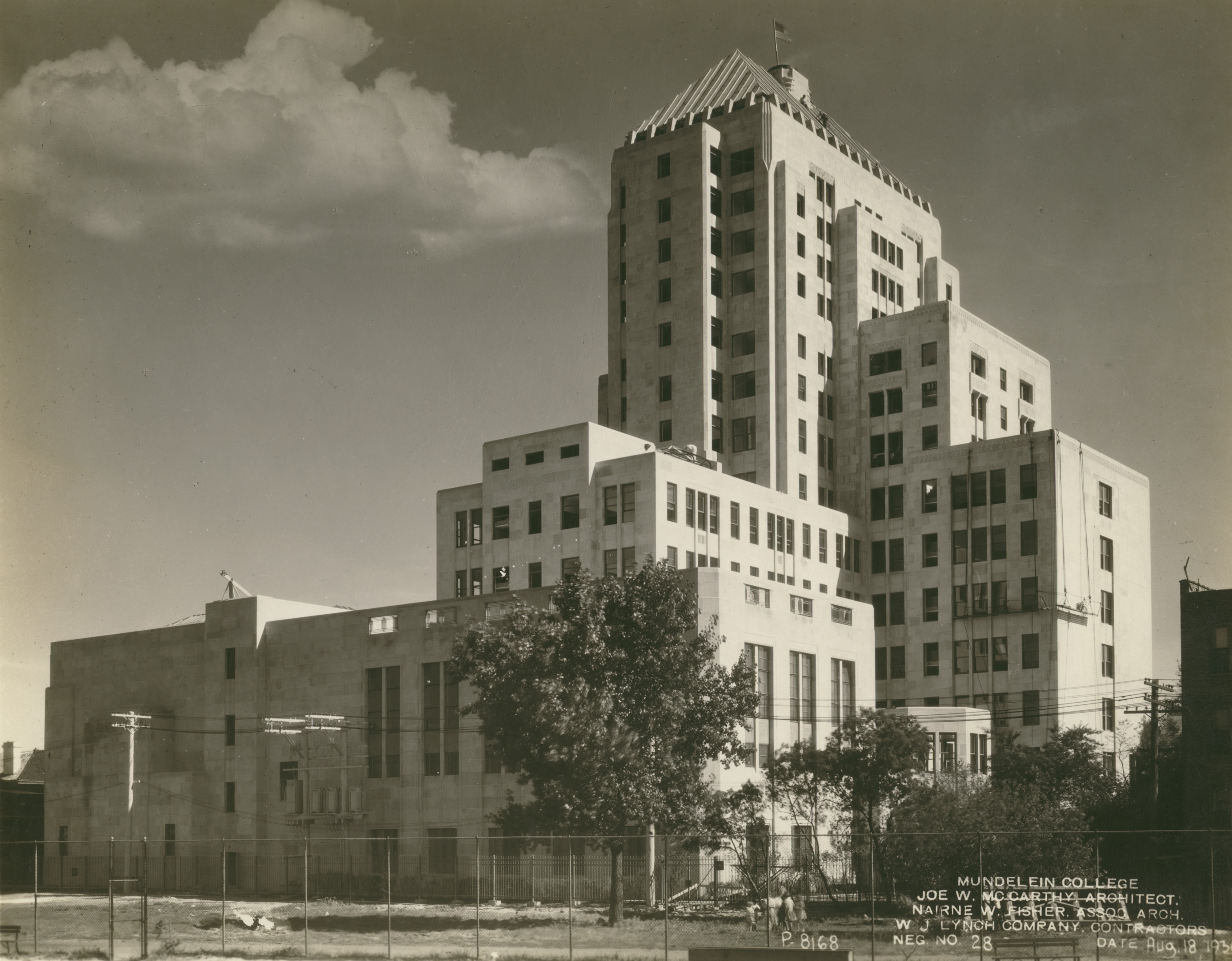
1930: Building: Skyscraper Construction (Preservica)
One month before classes were set to begin, thirteen BVM sisters moved from a cottage next door called the "little green house” into the newly opened Skyscraper. On September 29, 1930, 384 students began their classes in the new building which along with classrooms, also contained a chapel, auditorium, conservatory, gymnasium, swimming pool, tearoom, and library. It was an all-in-one space designed to serve the student’s needs with modern efficiency.
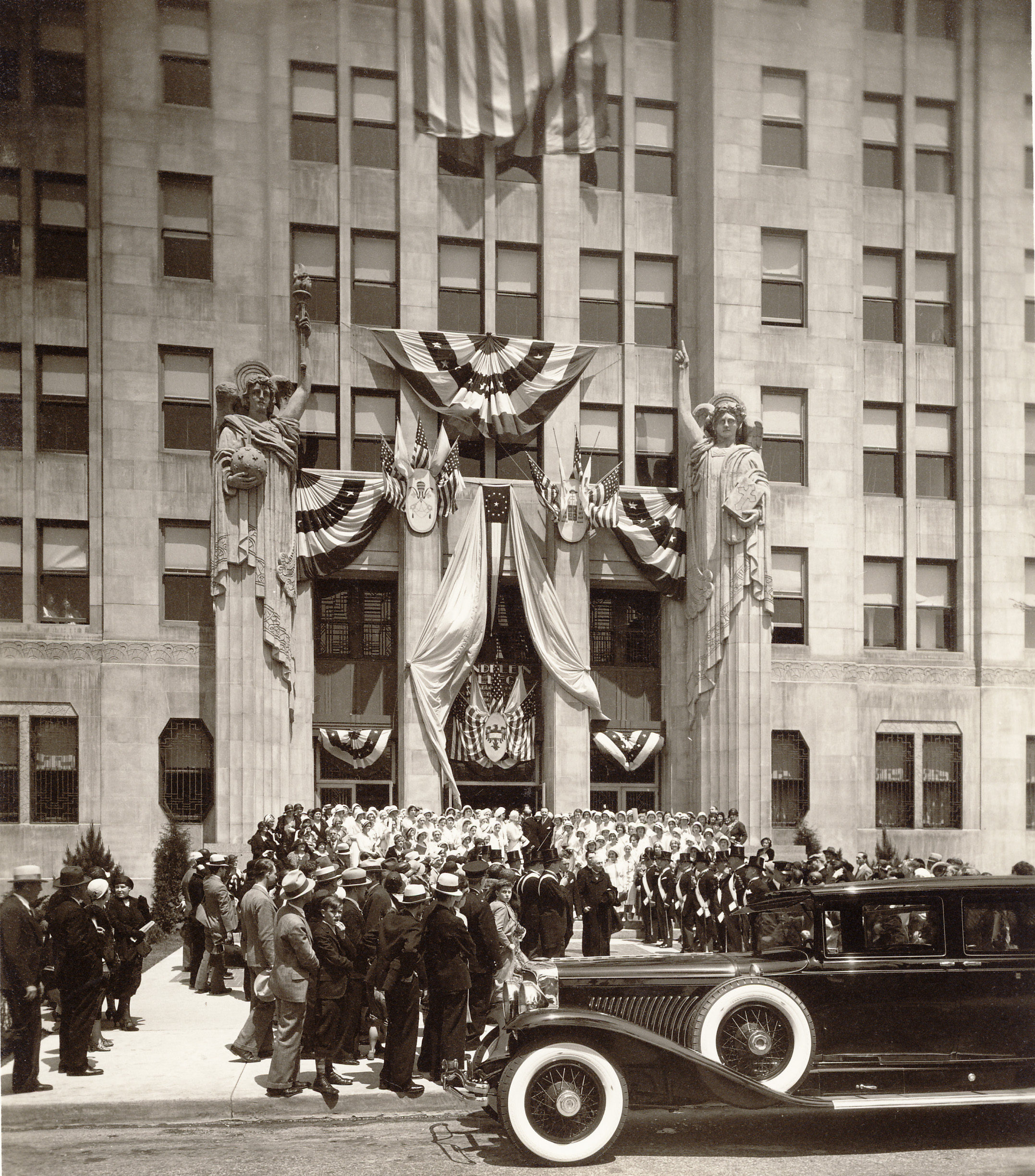
No senior-class students were admitted to Mundelein in its first year and so in the spring, instead of a graduation ceremony, the school hosted a formal dedication for the Skyscraper. Sister Justitia, now Mundelein’s first president, arranged the event in a grand style. She invited dignitaries, including Cardinal Mundelein, and engaged the Chicago police department to change the traffic on Sheridan Road for the occasion. She asked for the commissioner’s six most handsome officers mounted on the city’s finest horses to manage her request. The police chief agreed to dispatch the requested officers but sent them on motorcycles because the horses were needed downtown.

The finalized building’s exterior was styled in zigzag, geometric forms, tiered like layers of a cake. The Skyscraper embraced sharp edges. The bottom of the Skyscraper was the widest and the tower gradually narrowed via setbacks as it went up. The parallel lines gave it an aerodynamic look, fitting a new age of speed and technology of the early twentieth century. Whereas Nairne Fisher was the architect for the building, his brother Charles worked on the cut limestone stonework for the exterior. He crafted the guardian angels at the Skyscraper’s entrance, as well as the large friezes of crosses on the east and north sides building’s exterior. As the Skyscraper was a project of the Sisters of Charity of the Blessed Virgin Mary, the building incorporated an homage to the order in metal. The BVM crest and motto, Sicut lilias inter spinas (“Find the lily among thorns”) is located above the main entrance. The building also featured metal details elsewhere including on the doorplates, screens for radiators, and grillwork on the windows and porches.
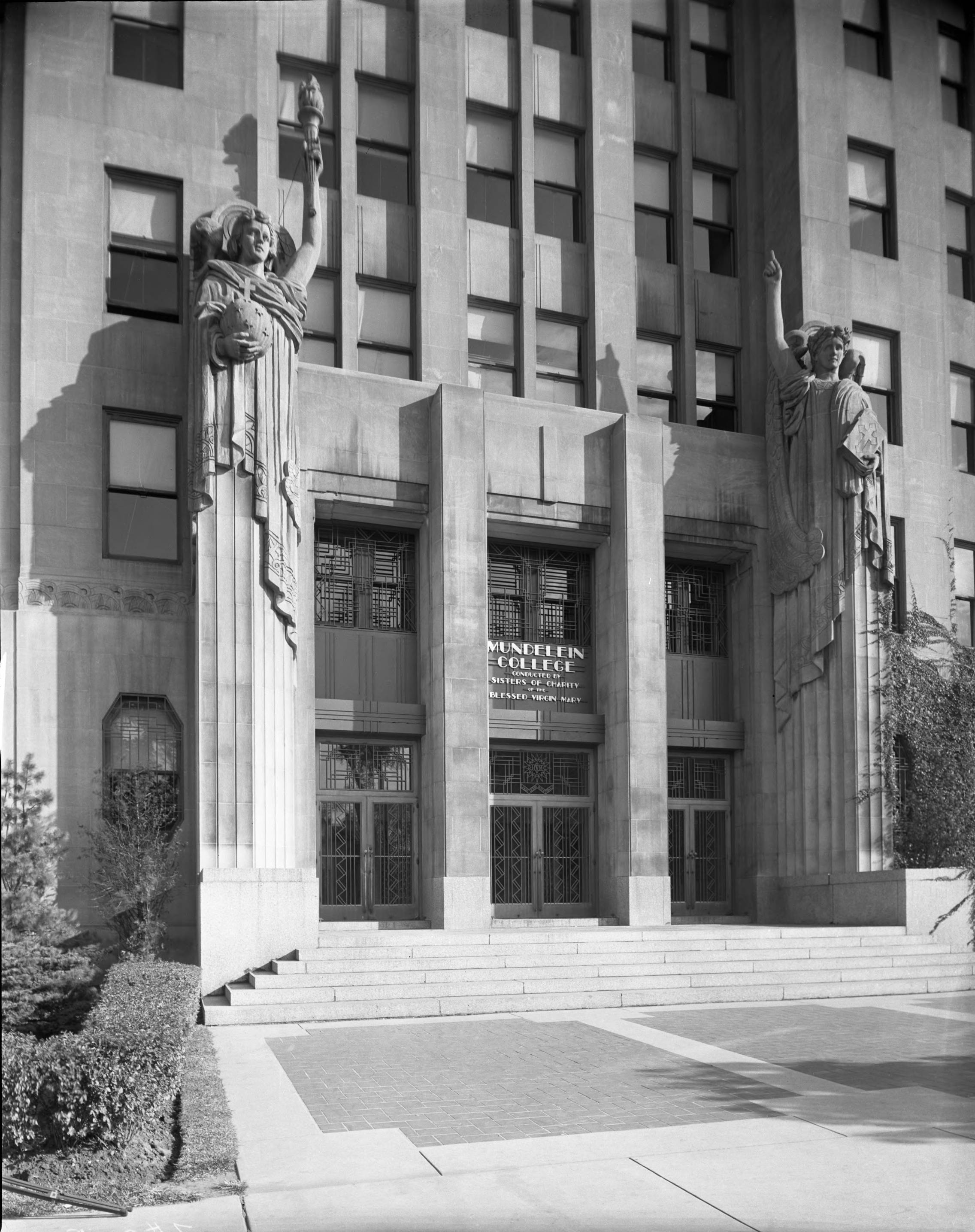
The architect Nairne Fisher clearly designed the building in the Art Deco style with the guardian angels above the south-facing main entrance making it stand out. The angels were not in Fisher’s original 1929 sketch of the building, but he added them later in response to a request from Mother Isabella. Each limestone angel stand four-stories high. The angel on the right, Uriel or “the Light of God,” holds the book of wisdom and signals with his hand to the cross on the fourteenth floor. The angel on the left, Jophiel or “the Beauty of God,” who protected the tree of knowledge, embraces the planet Earth and holds up the torch of knowledge. The Skyscraper’s guardian angels represented the reconciliation of Catholicism and modern American ideals – bringing together both religious tradition with avant-garde design. These elements were meant to remind both the campus community and the public of the college’s dedication to spirituality.
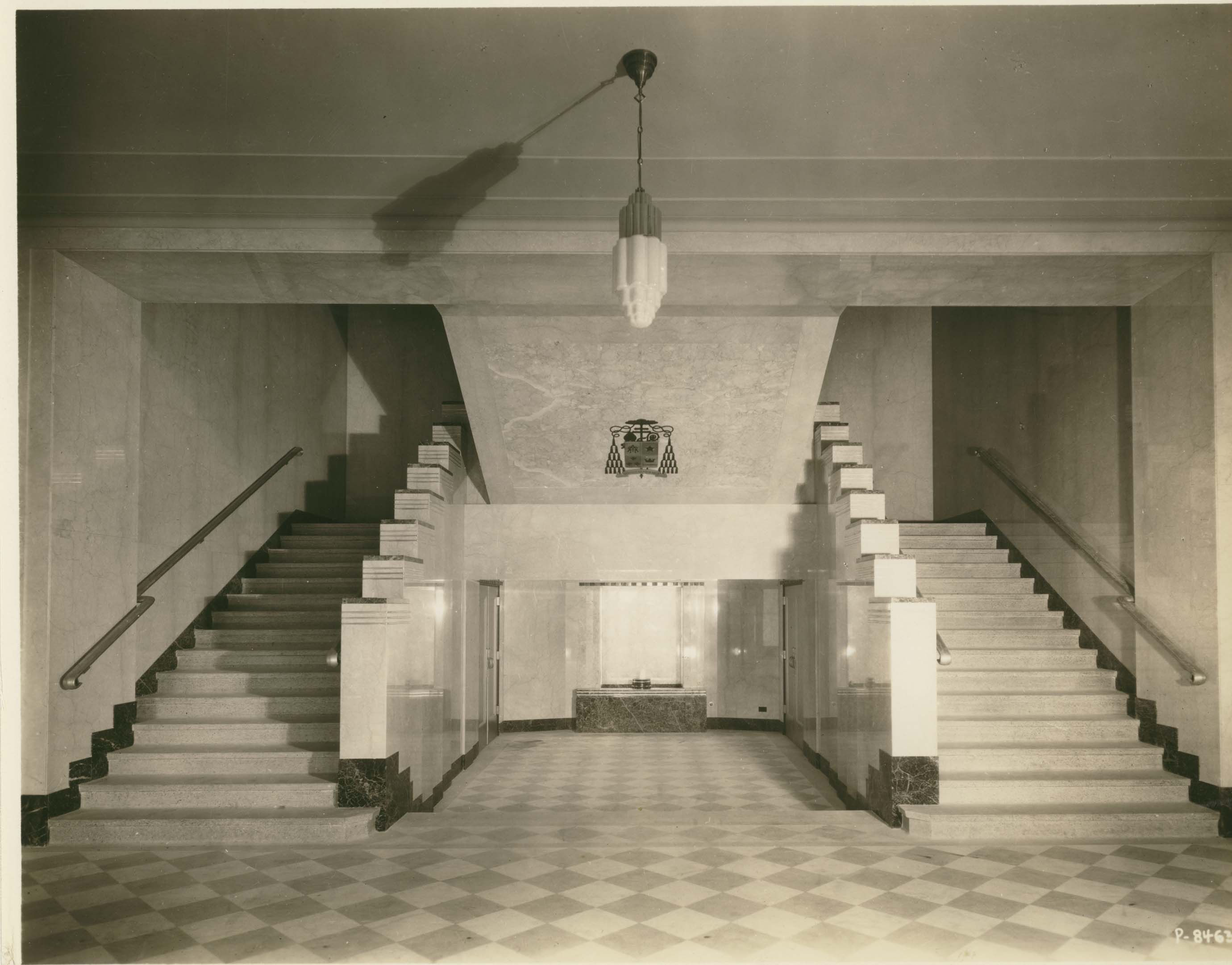
The Skyscraper’s interior echoes the exterior’s Art Deco style. Just inside the ironwork building entrance, the grand marble staircase features geometric setbacks with zigzag metal handrails. The front hall floor featuring rectangles arranged in a diamond pattern echoes the staircase’s geometric design. The shapes repeated throughout the building create the illusion of seemingly never-ending hallways, lending the space a formal and imposing atmosphere.
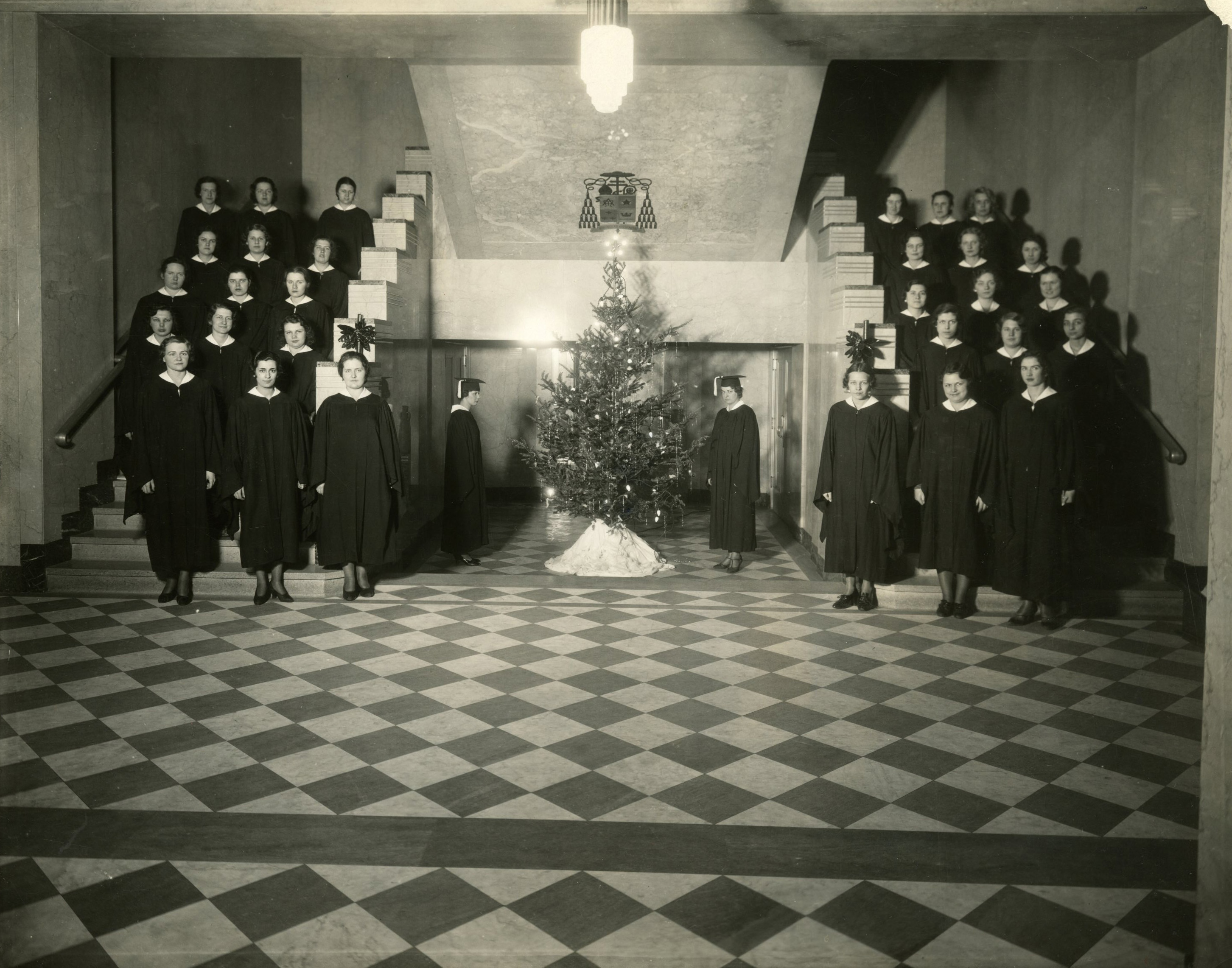
From the 1930s until well into the 1960s, Mundelein students and even faculty were trained to mirror the building’s formality. School authorities instructed both students and faculty to avoid using the grand marble staircase because it was reserved for special occasions like graduations or formal portraits. For some, this lent the entry’s marble showcase a mysterious quality. One former student called the flight of steps, “magical in a strange kind of way.” Students also followed other building rules beyond the staircase prohibition and abided by a dress code which required dresses, skirts, and sweaters for Skyscraper classes and for all formal assemblies, academic cap and gown—each with carefully measured hemlines equidistant from the floor.
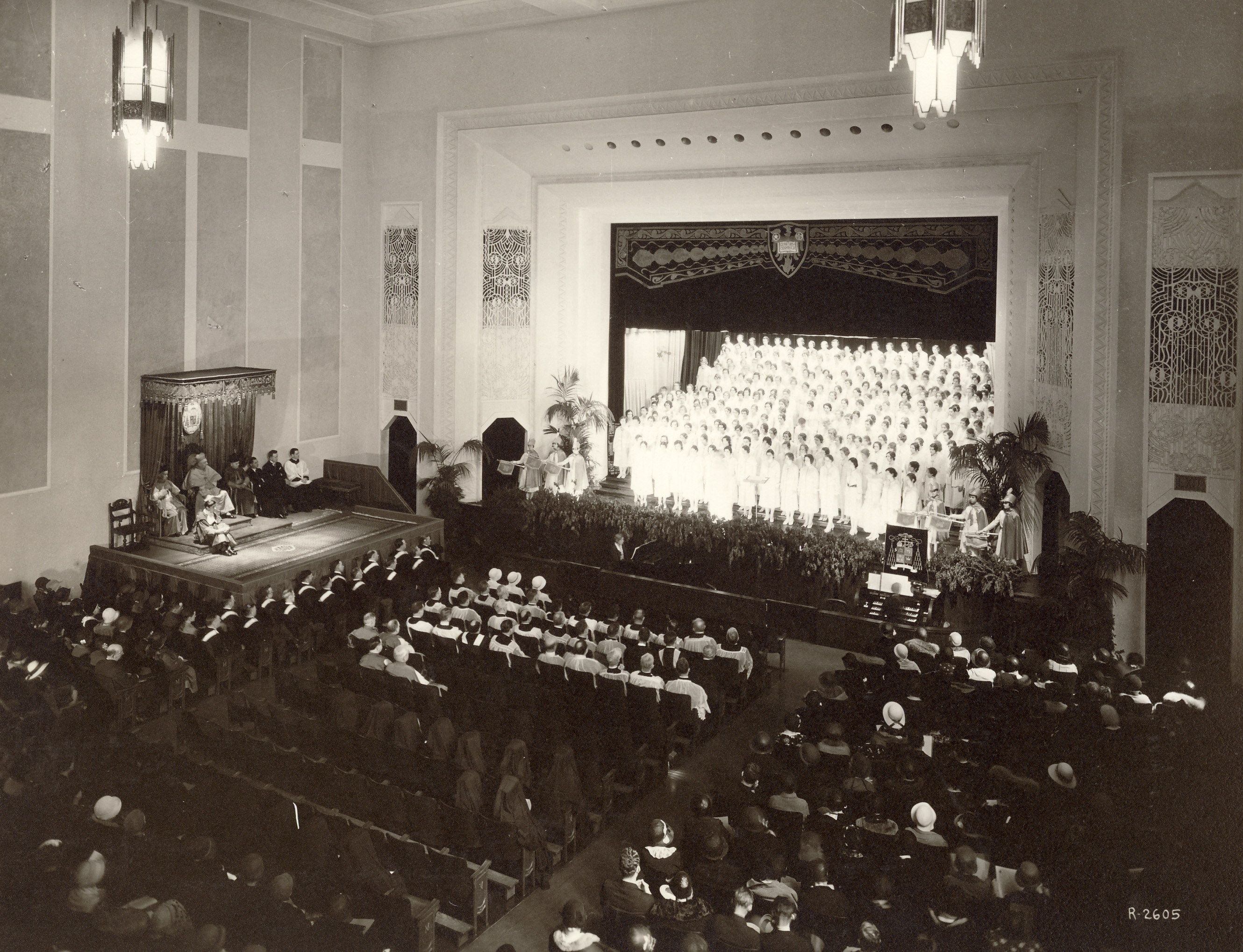
The auditorium hosted public meetings and performances and served as the heart of the skyscraper because it was the largest room in the entire building. Weekly assembly was mandatory for both students and faculty. Assemblies featured addresses given by Mundelein administration as well as talks by guest speakers. For formal programs, students were expected to wear a cap and gown with white gloves. Mandatory assemblies ended in the 1960s, but the college continued to use the space for a variety of events including performances. The Mundelein community organized a range of plays and musicals over the years including Twelfth Night in the 1930s which featured then-student and later-famous actress, Mercedes McCambridge.
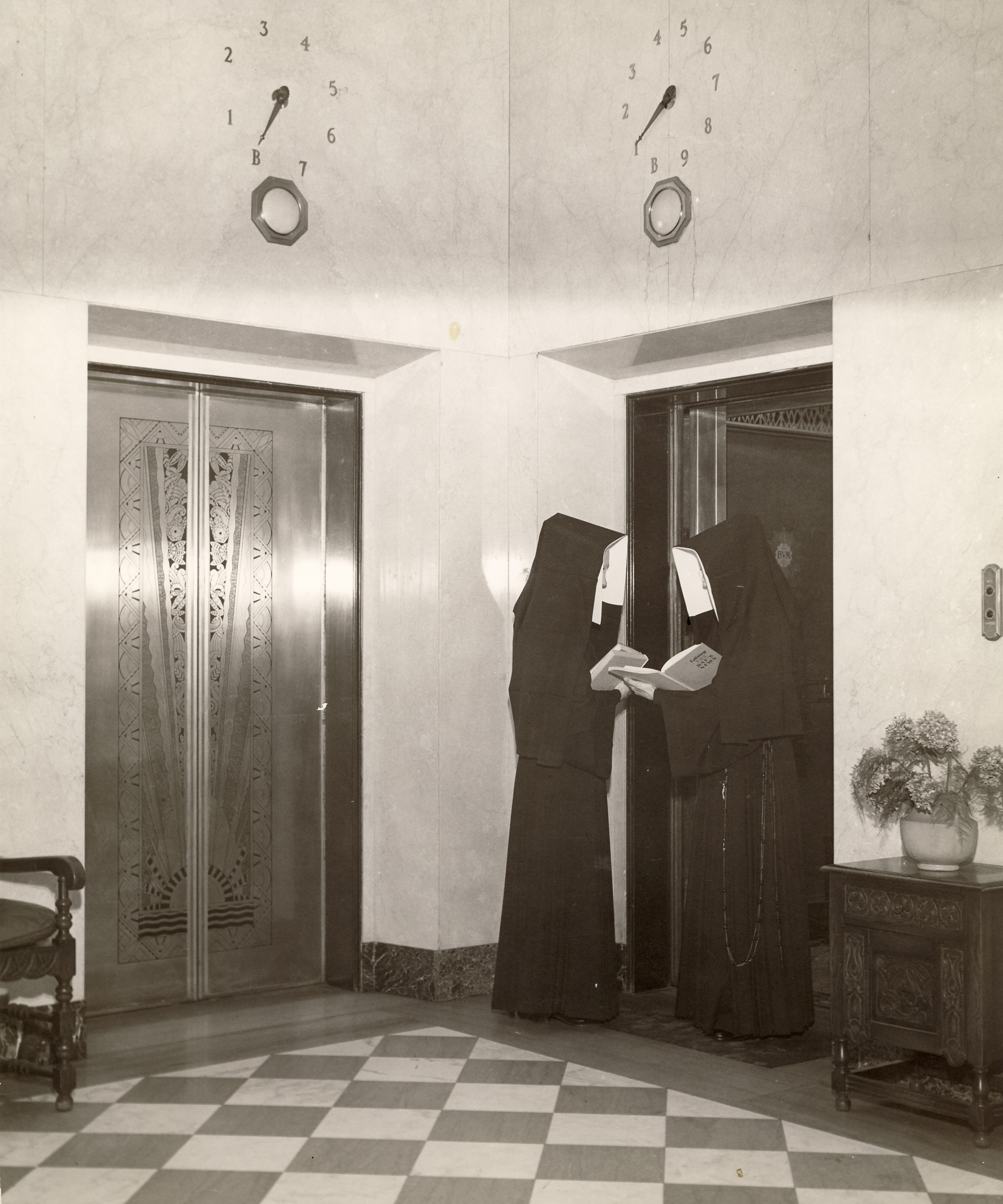
Like the grand staircase and the auditorium, the Skyscraper elevators also had rules surrounding their use. Most often, students climbed stairs and only used the lifts to go beyond the building’s first four floors. When it opened, the building contained two sets of manually operated elevators and neither set went beyond the building’s ninth floor. Instead, a strictly private interior staircase negotiated the last six floors of the fifteen-story building which featured residential spaces for the women religious who served as staff and faculty of the college.
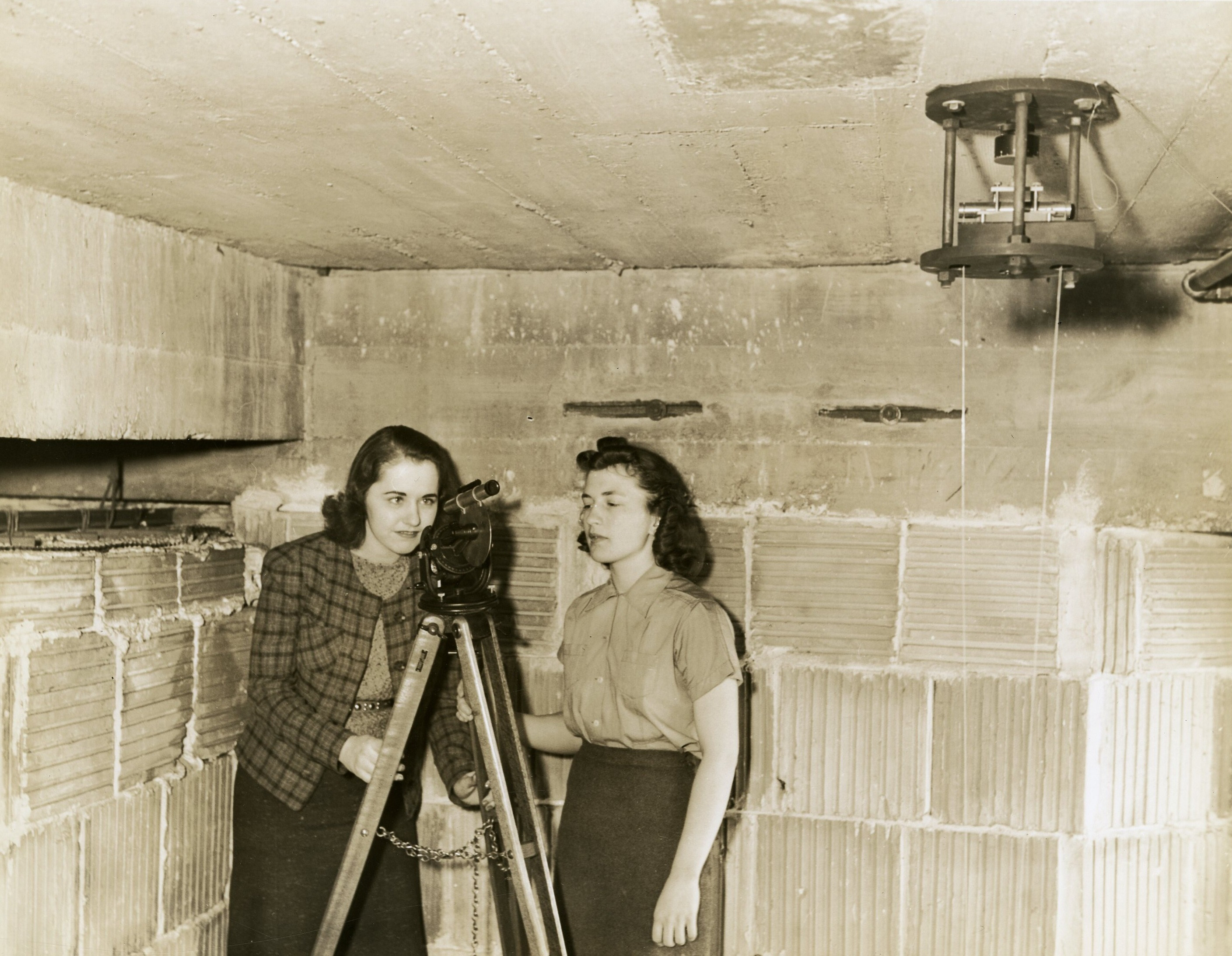
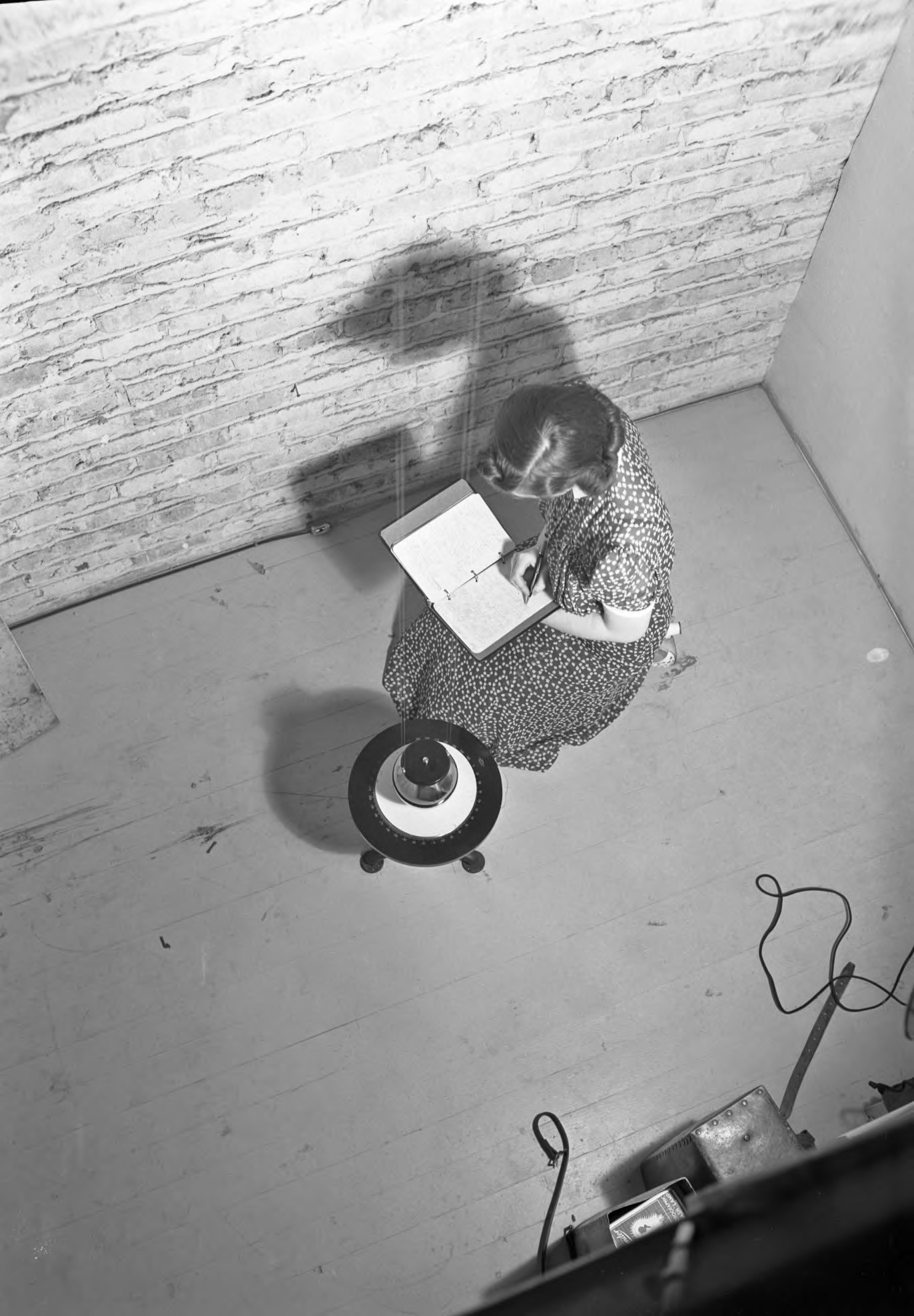
One elevator was not used for navigating the Skyscraper’s floors. Instead, it was the site for an ongoing physics experiment established in 1938 by Sister Mary Therese Langerbeck, BVM, a respected astrophysicist and Mundelein professor. Sister Mary Therese installed a Foucault pendulum, a device which provided a clear representation of the earth’s rotation. The instrument rested at the top of the elevator shaft and plunged downward for one hundred feet, spanning nine entire floors of the Skyscraper building. According to the Loyola World newspaper, when the pendulum was installed, it was the longest of its kind. Its accuracy was well-established and scientists from Chicago and around the country relied on its readings. The pendulum was retired in 1958 when Chicago’s Museum of Science and Industry installed a longer, more modern pendulum.
The BVM sisters started their teaching day by celebrating mass in the Skyscraper’s small sanctuary located on the building's second floor, the Stella Maris Chapel. Typically, a priest from Loyola University Chicago joined the women religious to serve for each morning's very early service. Before entering the sanctuary, the worshippers passed through the chapel corridor at the head of the building’s grand staircase. Two carved female forms bookended the chapel entry. The twin fifty-inch statuettes carved from Italian Bianco marble depicted St. Philomena, a Grecian princess martyred in second-century pagan Rome and the nineteenth-century St. Theresa of Liseux. According to the Mundelein student newspaper, The Skyscraper, the figures which represented both classical era and modern sainthood, symbolized the duration of the “spirit of Catholic womanhood” and the “ideal of twentieth-century college girls” which remained unchanged through the years.

Mundelein students also marked the opening of each academic day in the chapel where they took part in a 7:00 AM mass. They also sought solitude in the small sacred space for prayers and contemplation throughout the day. Stella Maris chapel also served as the destination for the annual candle lighting ceremony, the students’ final event before returning home for their Christmas holidays. The Christmas tradition featured a solemn procession through the building “from the tip of its toe to the top of its head” where students bearing candles arranged themselves in the Skyscraper’s south windows in the form of a candlelit cross. The light from the one-night “Skyscraper cross” was visible on Sheridan Road for a full mile. Each year its beauty stopped traffic and signaled the advent of a new Christmas season for the Rogers Park neighborhood of Chicago.

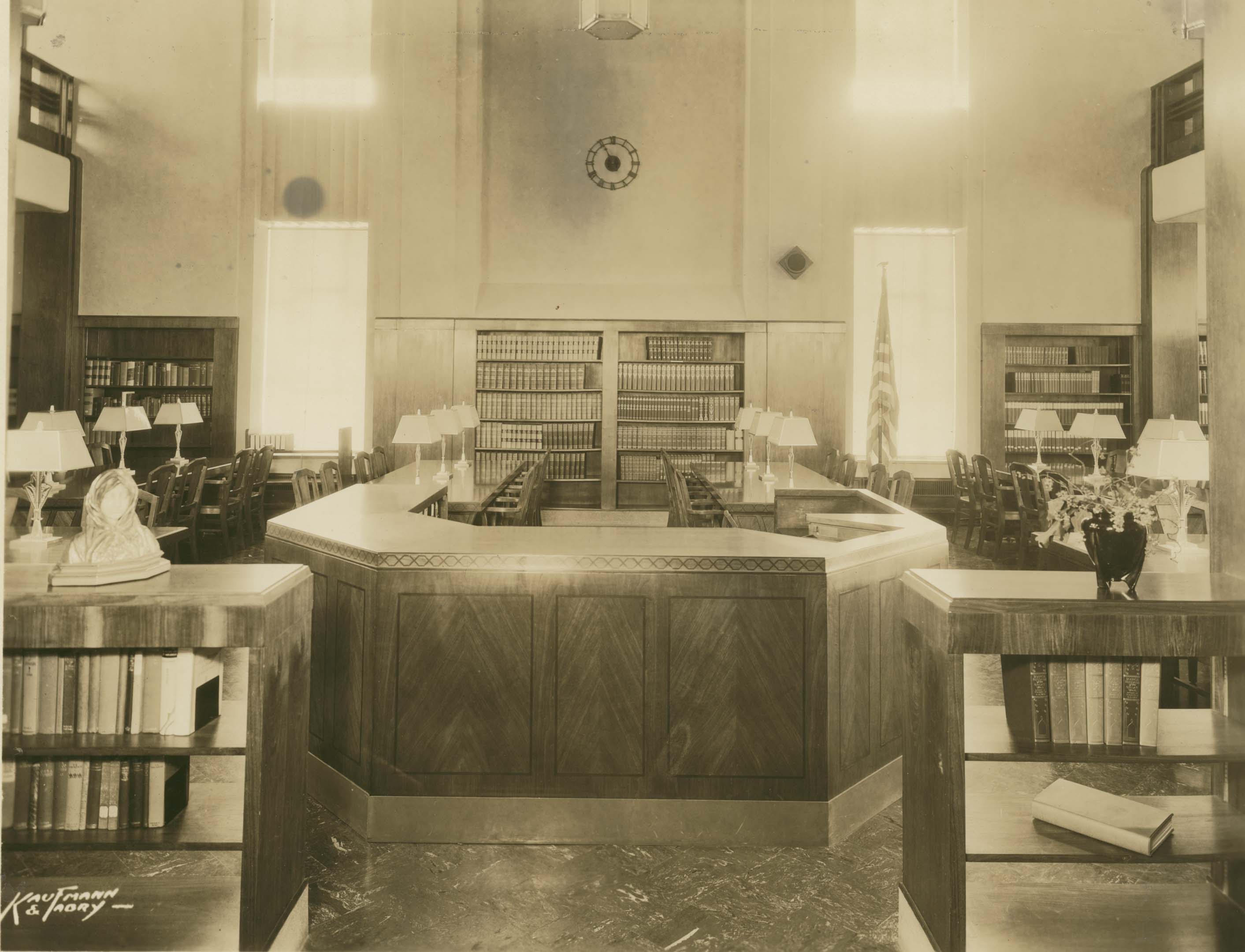
The library, located on the third and fourth floor, housed books from 1930 through 1934 when because of expansion, the college moved its contents to Piper Hall, the white stone mansion next door. The northeast corner of the Skyscraper library was known to students as the “book nook,” and featured carefully curated reading materials, an oriental rug, shade lamps, and comfortable overstuffed chairs. In addition to its role as a place of quiet study, the library also served as a training ground for library science majors under the tutelage of Sister Mary Robert Hugh, BVM. This program was a significant distinction for Mundelein because Chicago’s first academic program in the young field had just been initiated at the University of Chicago in the late 1920s. Mundelein’s collection included over nine thousand volumes which were encased in set-in shelves and free standing inlaid wooden cases which matched the Skyscraper’s Art Deco motif. Glass-faced cabinets on the east wall of the library’s balcony stored rare books, including incunabula, valuable fourteenth and fifteenth-century hand printed volumes.

On May 18, 1941, the college officially dedicated the new state of the art stargazing dome and the five-inch lens telescope housed in the observatory installed on the eighth floor. The refracting telescope was originally built for the Harvard University observatory by famous telescope maker, Alvin Clair. Reverend Austin Gallagher of St. Columbkille Church donated the scope and gifted the money for the construction of the dome. In the 1940s, a student club, the Amateur Astronomers frequented the observatory. They issued star maps for each month of the year and hosted stargazing social nights for their fellow Mundelein students.
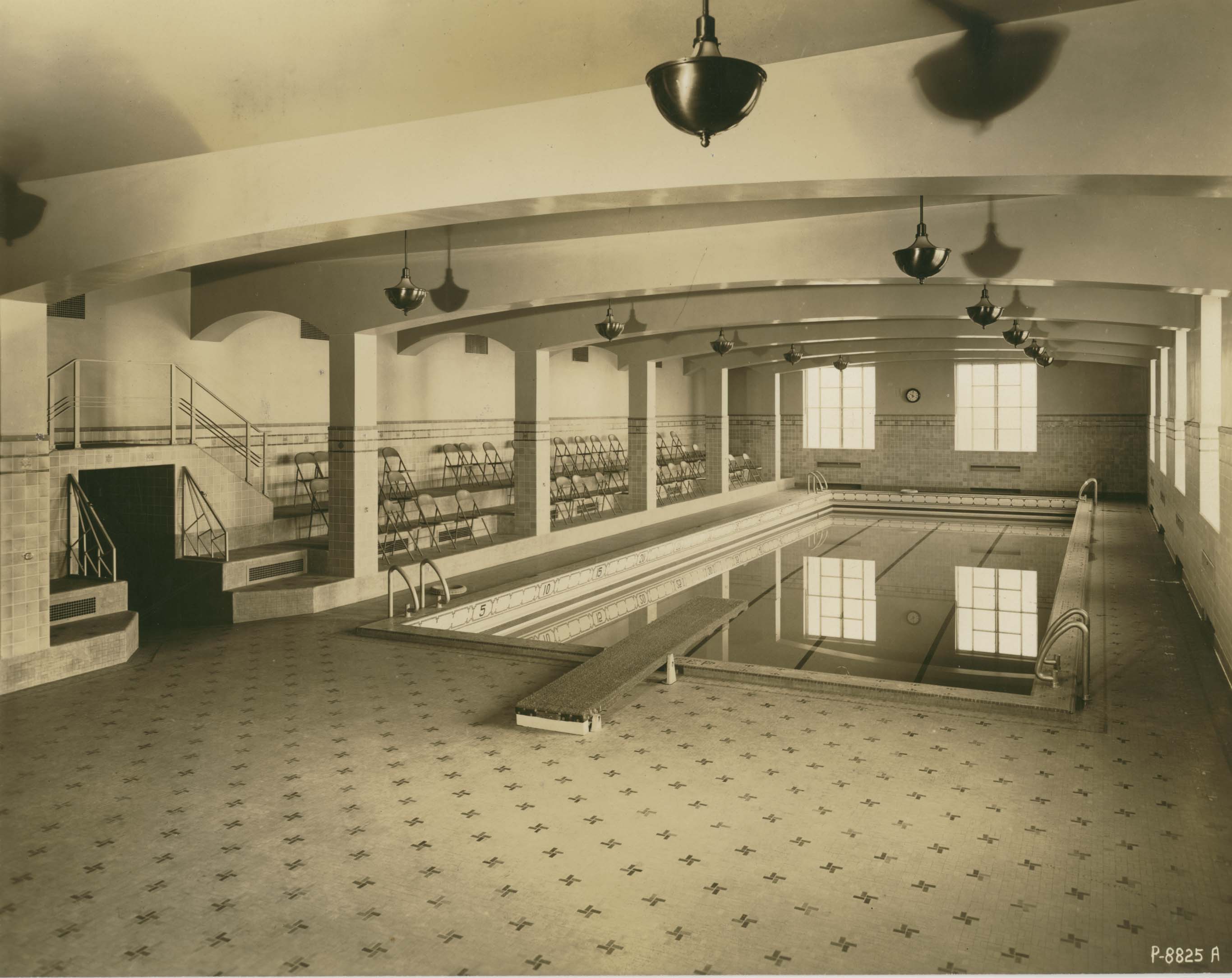


The swimming pool, located at the west end of the building’s ground floor, featured an arched ceiling, a broad bank of windows and a matching series of chandeliers which made for a generous and bright interior space. The pool served as a teaching, recreational, and competitive arena for Mundelein students. In addition to classes featuring Red Cross lifesaving certification and diving techniques, on Wednesday evenings, the collegiates gathered for a weekly swim night and indulged in the generous length and fifteen-foot depth of the pool. The pool also hosted the Mundelein Terrapins, the college’s competitive team, organized by students during the fall of the college’s first year. In the 1930s and 1940s, Terrapin members participated in races, diving contests, water ballets, and synchronized swimming events and hosted annual carnivals each spring semester.
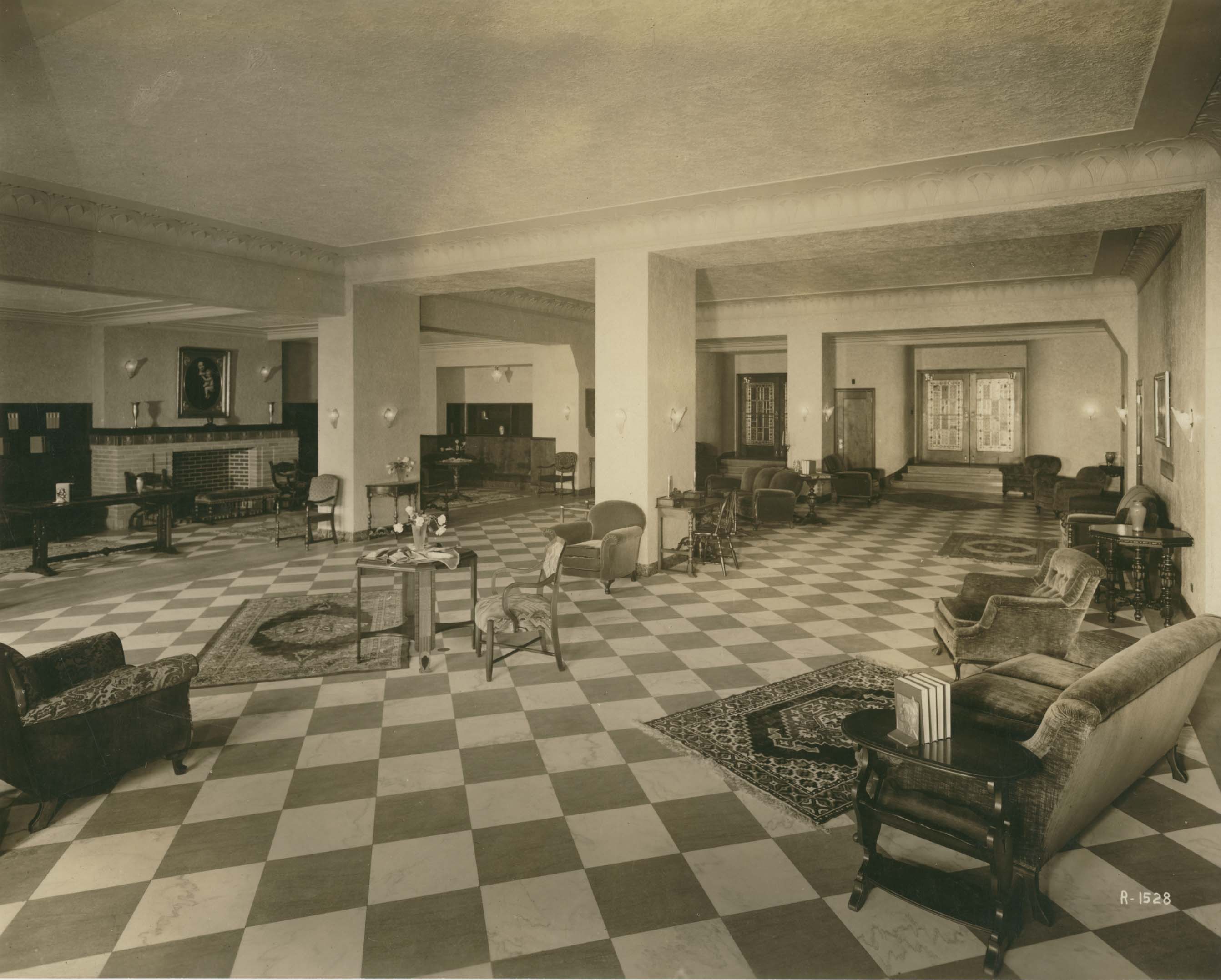


The social rooms’ modern lighting, diamond pattern marble flooring, and built-in furnishings revealed the building’s massive modern scale and emphasized their function as official reception rooms. At the same time, the carpets and multiple conversational seating arrangements created an approachable communal atmosphere suited for Mundelein faculty and students. In addition to their formal utility as sites for hosting dignitaries, the rooms also served as an arena for Mundelein student events including the annual fasion show hosted by the Home Economics department. The social rooms were also spaces set aside for ceremonial student occasions like the Mundelein senior class procession, a venerable tradition which began in 1932 and continued for several decades. Usually held before graduation, seniors donned their academic cap and gowns for the first time to march in procession through the halls of the Skyscraper from the social rooms to Stella Maris chapel.


Students gathered in the Skyscraper’s first floor cafeteria or what students called the “tearoom” for meals and just a chance to “meet with friends and sit around the tables.” The tearoom offered students a less formal space than the social rooms. Mundelein’s twenty-two academic, social, and athletic clubs including the Laertes student players hosted tearoom parties and events particularly at Christmas time, decorating the space to suit their own purposes. In 1955, the tearoom underwent a thorough "modernist” update and added new wall coverings, blue sequined upholstered chairs, and patterned sand and turquoise drapes designed by the well-known Chicago-based textile designer, Ben Rose.
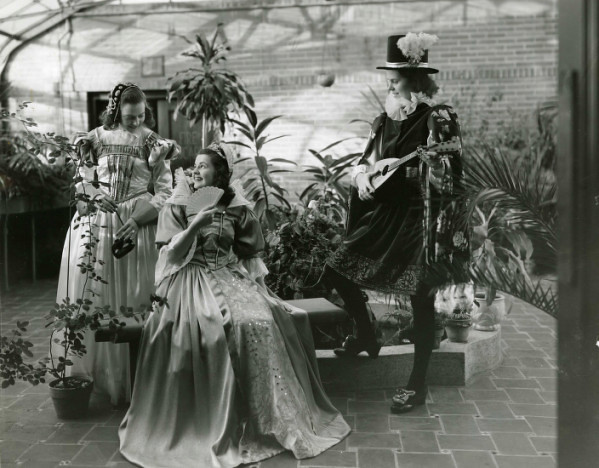
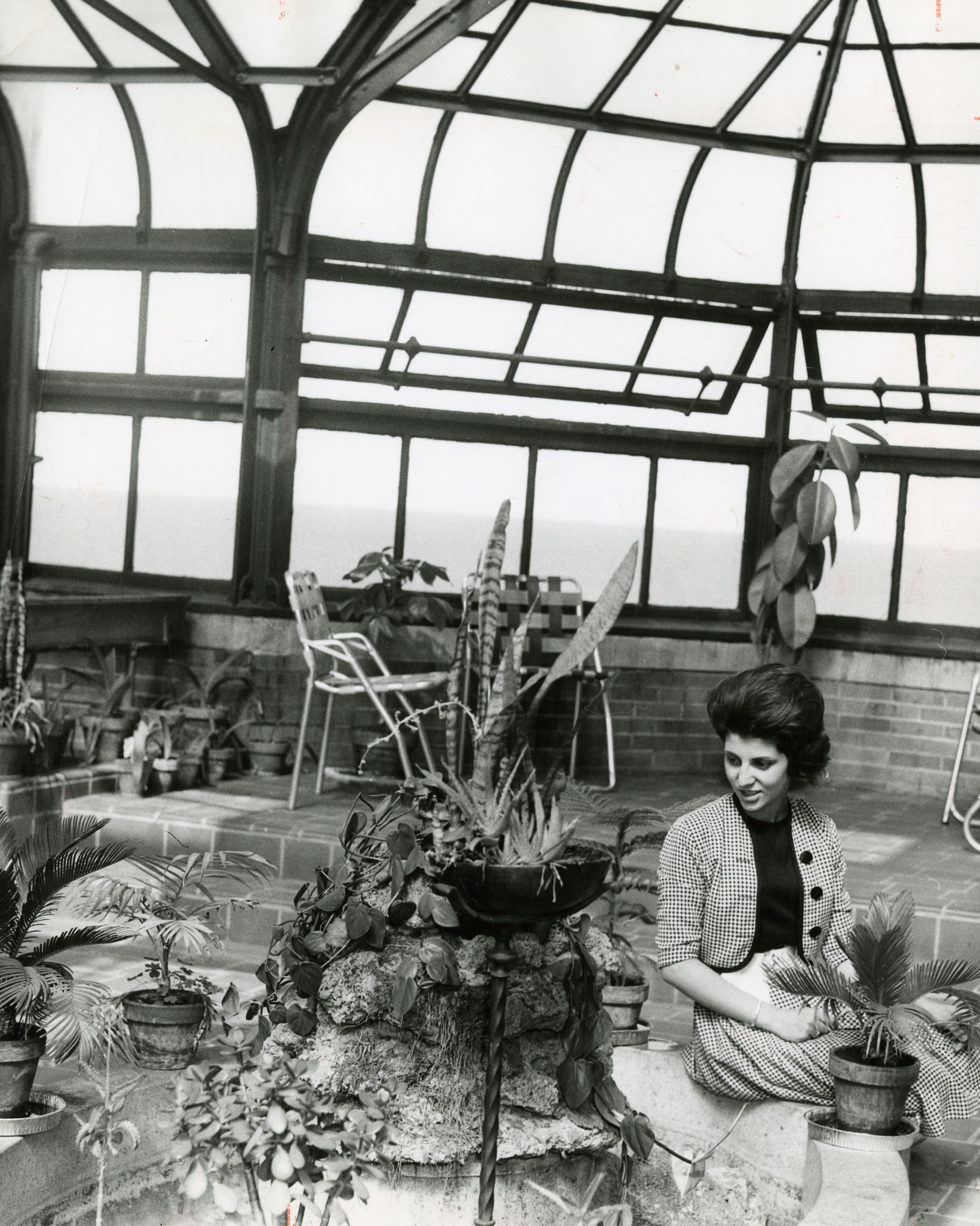
The seventh-floor conservatory, also known as the solarium, was a unique space in the Skyscraper. The conservatory featured a flowing fountain, birds, plants, and views over the city. In addition to providing a pleasant environment for the Mundelein community, the space also served as a laboratory for botany students. In the late 1940s at the suggestion of Cardinal Stritch, a smoking room opened in the conservatory, and it continued to be an informal gathering space for students well into the 1960s.
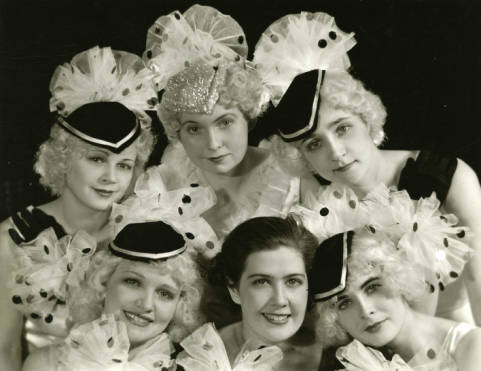

The Mundelein Skyscraper adapted with major changes in the 1990s, including the affiliation of Mundelein College with Loyola University Chicago in 1991. It continued to be used for academic and social activities until Loyola, with the help of architects from Baranski Hammer Moretta & Sheehy, completely renovated the interior of the building beginning in 2004. In fall 2012, Loyola rededicated the building as the Mundelein Center for the Fine and Performing Arts. As the center, the Skyscraper features 57 classrooms, offices, and a variety of performance spaces.
In 2022, it was announced that the Mundelein Auditorium would be renamed Jo Ann Rooney Hall in honor of Loyola's first layperson and first woman president. Dr. Jo Ann Rooney was president of Loyola 2016-2022.
Mundelein Center for Fine and Performing Arts

History
In 1930, the Sisters of Charity of the Blessed Virgin Mary (BVM) opened the ornate metalwork doors of the Mundelein College Skyscraper building to students for the first time. In 1980, the steel and concrete building was listed on the National Register of Historic Places because of its Art Deco design and its unique place in history as the only self-contained modern skyscraper constructed for the express purpose of educating women. For sixty-one years, the building hosted Mundelein College, and in 1991, when Mundelein affiliated with Loyola, it became a vital part of Loyola University Chicago’s Lake Shore Campus. In 2008, the building was restored and is now home to Loyola’s Mundelein Center for Fine and Performing Arts.
Download the Skyscraper Building Fact Sheet!
.jpg)
Projected blueprint for the Skyscraper conceived of in the colonial style.
Women and Leadership Archives Image 2959
From its inception, Mundelein co-founders, Mother Isabella Kane, BVM and Sister Justitia Coffey, BVM had a clear idea of the kind of building they hoped for. Historian Prudence Moylan asserts that both women were “attuned to the tempo of their times.” The building they envisioned needed to be a skyscraper for practical reasons because land was not cheap in the city. In addition, the space they hoped for would be set in a modern building built in a twentieth-century style because Mundelein would be a school for women who would function in the commercial city of Chicago. Mother Isabella and Sister Justitia preferred the clean lines of more modern architecture and were determined to carry out their plan despite a difference of opinion with Cardinal George William Mundelein, their superior. The Cardinal appointed the first architect of the building, Joseph McCarthy, who aimed to give the building a colonial appearance reflected in the blueprint above. Mother Isabella responded by hiring a younger architect, Nairne Fisher to conceive of a skyscraper in the Art Deco style which had been popularized in the 1925 Paris World’s Fair. The form symbolized both the beauty and efficiency of the modern world.

1930: building: Skyscraper Construction

1930: Building: Skyscraper Construction
Sister Justitia closely supervised the building’s construction. She started each day with a brisk walk down Rosemont and Kenmore Avenues towards the rising building on Sheridan Road accompanied by a young novitiate (a woman religious in training) and a tricolor collie named Prince. While they strolled on the site, Sister Justitia discussed workflow with the construction manager, William Lynch, and the many builders whom she knew by name. During construction, she also kept close tabs on permits with officials in downtown Chicago and assured a steady stream of incoming supplies with merchants so that the school could open its doors to students the following fall.

1930: Building: Skyscraper Construction (Preservica)
One month before classes were set to begin, thirteen BVM sisters moved from a cottage next door called the "little green house” into the newly opened Skyscraper. On September 29, 1930, 384 students began their classes in the new building which along with classrooms, also contained a chapel, auditorium, conservatory, gymnasium, swimming pool, tearoom, and library. It was an all-in-one space designed to serve the student’s needs with modern efficiency.

No senior-class students were admitted to Mundelein in its first year and so in the spring, instead of a graduation ceremony, the school hosted a formal dedication for the Skyscraper. Sister Justitia, now Mundelein’s first president, arranged the event in a grand style. She invited dignitaries, including Cardinal Mundelein, and engaged the Chicago police department to change the traffic on Sheridan Road for the occasion. She asked for the commissioner’s six most handsome officers mounted on the city’s finest horses to manage her request. The police chief agreed to dispatch the requested officers but sent them on motorcycles because the horses were needed downtown.

The finalized building’s exterior was styled in zigzag, geometric forms, tiered like layers of a cake. The Skyscraper embraced sharp edges. The bottom of the Skyscraper was the widest and the tower gradually narrowed via setbacks as it went up. The parallel lines gave it an aerodynamic look, fitting a new age of speed and technology of the early twentieth century. Whereas Nairne Fisher was the architect for the building, his brother Charles worked on the cut limestone stonework for the exterior. He crafted the guardian angels at the Skyscraper’s entrance, as well as the large friezes of crosses on the east and north sides building’s exterior. As the Skyscraper was a project of the Sisters of Charity of the Blessed Virgin Mary, the building incorporated an homage to the order in metal. The BVM crest and motto, Sicut lilias inter spinas (“Find the lily among thorns”) is located above the main entrance. The building also featured metal details elsewhere including on the doorplates, screens for radiators, and grillwork on the windows and porches.

The architect Nairne Fisher clearly designed the building in the Art Deco style with the guardian angels above the south-facing main entrance making it stand out. The angels were not in Fisher’s original 1929 sketch of the building, but he added them later in response to a request from Mother Isabella. Each limestone angel stand four-stories high. The angel on the right, Uriel or “the Light of God,” holds the book of wisdom and signals with his hand to the cross on the fourteenth floor. The angel on the left, Jophiel or “the Beauty of God,” who protected the tree of knowledge, embraces the planet Earth and holds up the torch of knowledge. The Skyscraper’s guardian angels represented the reconciliation of Catholicism and modern American ideals – bringing together both religious tradition with avant-garde design. These elements were meant to remind both the campus community and the public of the college’s dedication to spirituality.

The Skyscraper’s interior echoes the exterior’s Art Deco style. Just inside the ironwork building entrance, the grand marble staircase features geometric setbacks with zigzag metal handrails. The front hall floor featuring rectangles arranged in a diamond pattern echoes the staircase’s geometric design. The shapes repeated throughout the building create the illusion of seemingly never-ending hallways, lending the space a formal and imposing atmosphere.

From the 1930s until well into the 1960s, Mundelein students and even faculty were trained to mirror the building’s formality. School authorities instructed both students and faculty to avoid using the grand marble staircase because it was reserved for special occasions like graduations or formal portraits. For some, this lent the entry’s marble showcase a mysterious quality. One former student called the flight of steps, “magical in a strange kind of way.” Students also followed other building rules beyond the staircase prohibition and abided by a dress code which required dresses, skirts, and sweaters for Skyscraper classes and for all formal assemblies, academic cap and gown—each with carefully measured hemlines equidistant from the floor.

The auditorium hosted public meetings and performances and served as the heart of the skyscraper because it was the largest room in the entire building. Weekly assembly was mandatory for both students and faculty. Assemblies featured addresses given by Mundelein administration as well as talks by guest speakers. For formal programs, students were expected to wear a cap and gown with white gloves. Mandatory assemblies ended in the 1960s, but the college continued to use the space for a variety of events including performances. The Mundelein community organized a range of plays and musicals over the years including Twelfth Night in the 1930s which featured then-student and later-famous actress, Mercedes McCambridge.

Like the grand staircase and the auditorium, the Skyscraper elevators also had rules surrounding their use. Most often, students climbed stairs and only used the lifts to go beyond the building’s first four floors. When it opened, the building contained two sets of manually operated elevators and neither set went beyond the building’s ninth floor. Instead, a strictly private interior staircase negotiated the last six floors of the fifteen-story building which featured residential spaces for the women religious who served as staff and faculty of the college.


One elevator was not used for navigating the Skyscraper’s floors. Instead, it was the site for an ongoing physics experiment established in 1938 by Sister Mary Therese Langerbeck, BVM, a respected astrophysicist and Mundelein professor. Sister Mary Therese installed a Foucault pendulum, a device which provided a clear representation of the earth’s rotation. The instrument rested at the top of the elevator shaft and plunged downward for one hundred feet, spanning nine entire floors of the Skyscraper building. According to the Loyola World newspaper, when the pendulum was installed, it was the longest of its kind. Its accuracy was well-established and scientists from Chicago and around the country relied on its readings. The pendulum was retired in 1958 when Chicago’s Museum of Science and Industry installed a longer, more modern pendulum.
The BVM sisters started their teaching day by celebrating mass in the Skyscraper’s small sanctuary located on the building's second floor, the Stella Maris Chapel. Typically, a priest from Loyola University Chicago joined the women religious to serve for each morning's very early service. Before entering the sanctuary, the worshippers passed through the chapel corridor at the head of the building’s grand staircase. Two carved female forms bookended the chapel entry. The twin fifty-inch statuettes carved from Italian Bianco marble depicted St. Philomena, a Grecian princess martyred in second-century pagan Rome and the nineteenth-century St. Theresa of Liseux. According to the Mundelein student newspaper, The Skyscraper, the figures which represented both classical era and modern sainthood, symbolized the duration of the “spirit of Catholic womanhood” and the “ideal of twentieth-century college girls” which remained unchanged through the years.

Mundelein students also marked the opening of each academic day in the chapel where they took part in a 7:00 AM mass. They also sought solitude in the small sacred space for prayers and contemplation throughout the day. Stella Maris chapel also served as the destination for the annual candle lighting ceremony, the students’ final event before returning home for their Christmas holidays. The Christmas tradition featured a solemn procession through the building “from the tip of its toe to the top of its head” where students bearing candles arranged themselves in the Skyscraper’s south windows in the form of a candlelit cross. The light from the one-night “Skyscraper cross” was visible on Sheridan Road for a full mile. Each year its beauty stopped traffic and signaled the advent of a new Christmas season for the Rogers Park neighborhood of Chicago.


The library, located on the third and fourth floor, housed books from 1930 through 1934 when because of expansion, the college moved its contents to Piper Hall, the white stone mansion next door. The northeast corner of the Skyscraper library was known to students as the “book nook,” and featured carefully curated reading materials, an oriental rug, shade lamps, and comfortable overstuffed chairs. In addition to its role as a place of quiet study, the library also served as a training ground for library science majors under the tutelage of Sister Mary Robert Hugh, BVM. This program was a significant distinction for Mundelein because Chicago’s first academic program in the young field had just been initiated at the University of Chicago in the late 1920s. Mundelein’s collection included over nine thousand volumes which were encased in set-in shelves and free standing inlaid wooden cases which matched the Skyscraper’s Art Deco motif. Glass-faced cabinets on the east wall of the library’s balcony stored rare books, including incunabula, valuable fourteenth and fifteenth-century hand printed volumes.

On May 18, 1941, the college officially dedicated the new state of the art stargazing dome and the five-inch lens telescope housed in the observatory installed on the eighth floor. The refracting telescope was originally built for the Harvard University observatory by famous telescope maker, Alvin Clair. Reverend Austin Gallagher of St. Columbkille Church donated the scope and gifted the money for the construction of the dome. In the 1940s, a student club, the Amateur Astronomers frequented the observatory. They issued star maps for each month of the year and hosted stargazing social nights for their fellow Mundelein students.



The swimming pool, located at the west end of the building’s ground floor, featured an arched ceiling, a broad bank of windows and a matching series of chandeliers which made for a generous and bright interior space. The pool served as a teaching, recreational, and competitive arena for Mundelein students. In addition to classes featuring Red Cross lifesaving certification and diving techniques, on Wednesday evenings, the collegiates gathered for a weekly swim night and indulged in the generous length and fifteen-foot depth of the pool. The pool also hosted the Mundelein Terrapins, the college’s competitive team, organized by students during the fall of the college’s first year. In the 1930s and 1940s, Terrapin members participated in races, diving contests, water ballets, and synchronized swimming events and hosted annual carnivals each spring semester.



The social rooms’ modern lighting, diamond pattern marble flooring, and built-in furnishings revealed the building’s massive modern scale and emphasized their function as official reception rooms. At the same time, the carpets and multiple conversational seating arrangements created an approachable communal atmosphere suited for Mundelein faculty and students. In addition to their formal utility as sites for hosting dignitaries, the rooms also served as an arena for Mundelein student events including the annual fasion show hosted by the Home Economics department. The social rooms were also spaces set aside for ceremonial student occasions like the Mundelein senior class procession, a venerable tradition which began in 1932 and continued for several decades. Usually held before graduation, seniors donned their academic cap and gowns for the first time to march in procession through the halls of the Skyscraper from the social rooms to Stella Maris chapel.


Students gathered in the Skyscraper’s first floor cafeteria or what students called the “tearoom” for meals and just a chance to “meet with friends and sit around the tables.” The tearoom offered students a less formal space than the social rooms. Mundelein’s twenty-two academic, social, and athletic clubs including the Laertes student players hosted tearoom parties and events particularly at Christmas time, decorating the space to suit their own purposes. In 1955, the tearoom underwent a thorough "modernist” update and added new wall coverings, blue sequined upholstered chairs, and patterned sand and turquoise drapes designed by the well-known Chicago-based textile designer, Ben Rose.


The seventh-floor conservatory, also known as the solarium, was a unique space in the Skyscraper. The conservatory featured a flowing fountain, birds, plants, and views over the city. In addition to providing a pleasant environment for the Mundelein community, the space also served as a laboratory for botany students. In the late 1940s at the suggestion of Cardinal Stritch, a smoking room opened in the conservatory, and it continued to be an informal gathering space for students well into the 1960s.


The Mundelein Skyscraper adapted with major changes in the 1990s, including the affiliation of Mundelein College with Loyola University Chicago in 1991. It continued to be used for academic and social activities until Loyola, with the help of architects from Baranski Hammer Moretta & Sheehy, completely renovated the interior of the building beginning in 2004. In fall 2012, Loyola rededicated the building as the Mundelein Center for the Fine and Performing Arts. As the center, the Skyscraper features 57 classrooms, offices, and a variety of performance spaces.
In 2022, it was announced that the Mundelein Auditorium would be renamed Jo Ann Rooney Hall in honor of Loyola's first layperson and first woman president. Dr. Jo Ann Rooney was president of Loyola 2016-2022.
